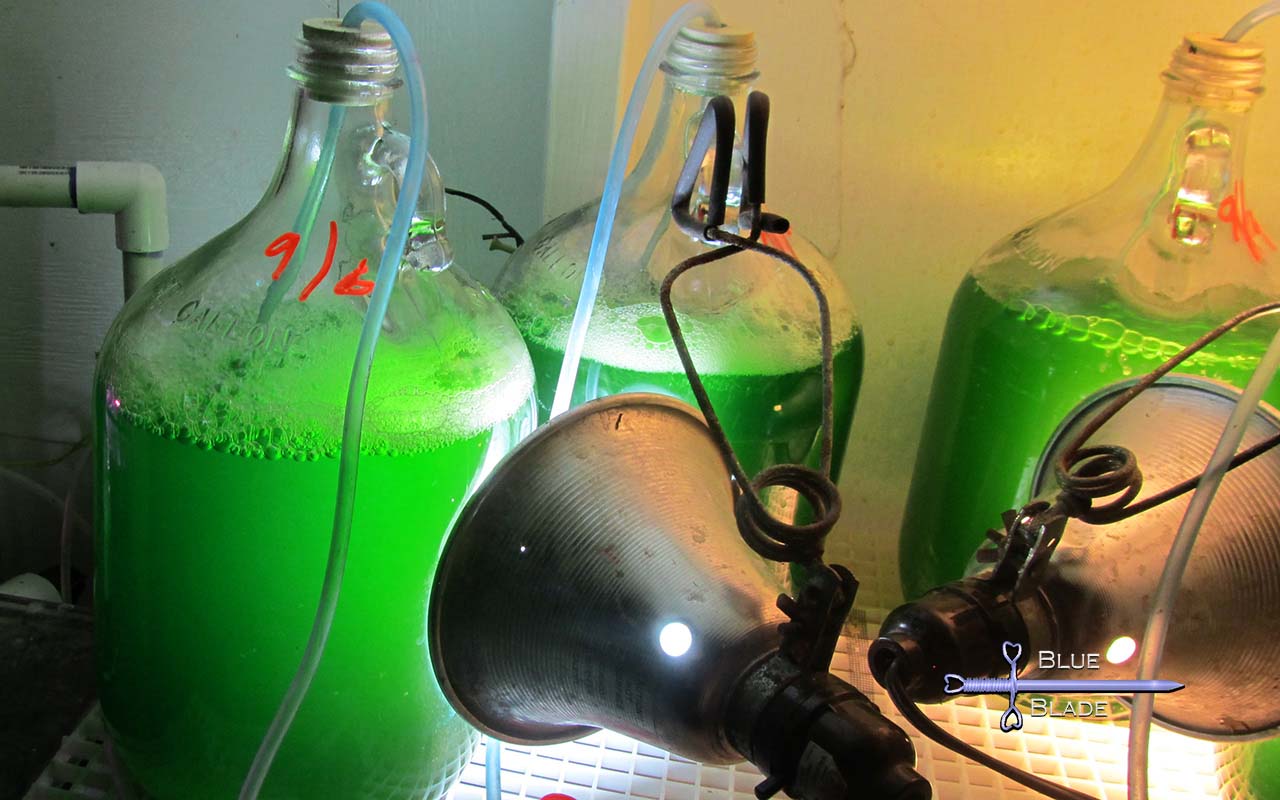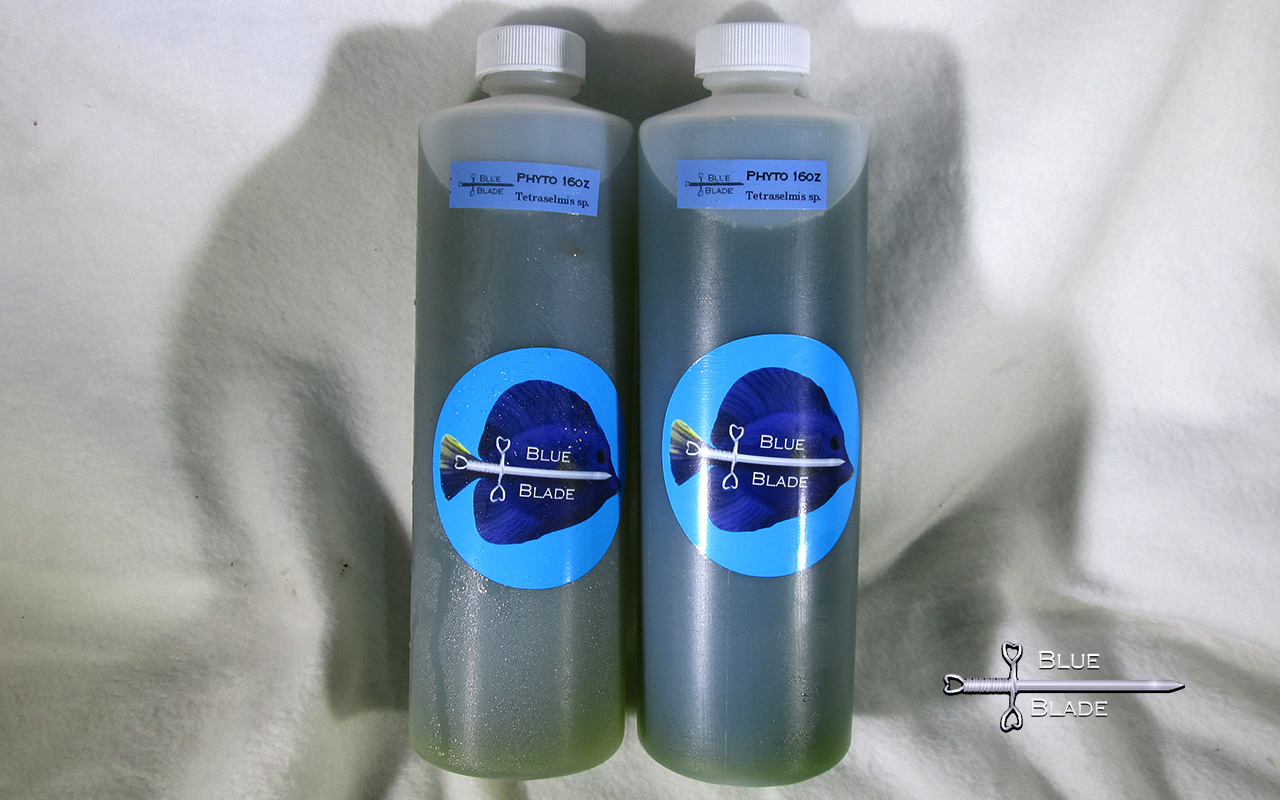
Materials:
1) Two or more bottles or jugs, with drilled lids or stoppers
2) air pump (standard aquarium bubbler)
3) airline tubing, air stones, and gang valve
4) F/2 nutrient solution/fertilizer
5) Marine salt
6) RO or distilled water
7) Phyto starter for culture
Culturing phytoplankton very similar to greenwater, except that marine phyto is not as hardy. It can become easily contaminated and die off, settle out, or get eaten by contaminating ciliates. You should start with a monoculture of a single strain of algae such as Tetraselmis or Nannochloropsis. The different species can be combined after harvesting. Mixed cultures are not suitable for re-culture.
We almost always have Tetraselmis Phyto in stock and for sale, that is suitable for re-culture.

Once you have your starter, it's time to grow and propagate.
There are only a few requirements to keep the phyto growing:
1) A sterile environment
2) light
3) nutrients
4) water
Keep it sterile:
It is not common for the water in your marine or reef tank to turn green. Even when nutrients and light are high, algae will usually stick to the rocks and glass rather than float in the water column. That makes it safe to dose Phyto without having a bright green tank for the next week. This is partially due to the efficiency of microfauna in consuming it. If any of that microfauna gets into your culture it will rapidly deteriorate and become useless.
Scrub, bleach, rinse, and dry everything that may touch the culture before working with it. Wash your hands. Wash the tabletop. If possible, work with it and culture it in a separate room - away from any marine tanks.
Don't feed from your main culture. Use separate bottles for feeding and storage that you can wash and sterilize before refilling. Phyto is not hard, but you must keep it from becoming contaminated.
Light:
I use a cheap reflector lamp from the hardware store and a full spectrum CFL bulb. Place the lamp right up against the jugs (or just a few inches away if you use plastic). By positioning the light between the jugs, you can provide high illumination to two jugs per lamp.
I keep the light on 24 hours per day. I have not tested with only sunlight or shorter light cycles. Sunlight in addition to the electric light does seem to be beneficial but is not necessary.
This is also where the bubbler and air stone come into play; place the air stone in the bottom of the jug and set the air flow so that the water appears to barely boil. This helps keep the algae in suspension and allows it to be constantly moving, so that all of it gets exposed to the light. If you have foam forming, you should reduce the air flow and/or use a coarser air stone (or no air stone). Try to adjust so that you get the most water movement you can without foaming.

Nutrients:
For Phytoplankton I use Guillard's F/2 culture medium. I have had best results with F/2. I have had limited success in the past with miracle grow plant food and Enfamil powdered baby formula for fertilizer. It is probably fine. My issues were probably all contamination related. However, there is also the risk that it may contain excess metals such as copper.
We have recently started mixing our own Guillard's F/2 culture medium - and offering it for sale.
Add nutrients every 3 to 5 days or when starting or splitting a culture.
Water:
Good water is important in all aspects of fish husbandry, but there are some details unique to marine algae cultures. You will need de-chlorinated water, as the chlorine will kill the microorganisms you are trying to grow. However, for Phyto you also need sterile salt water. Do not use water from an old aquarium or rainwater. That will crash the culture. RO or distilled water is generally better to use than tap water because you have more control over the mineral and metal content. Tap water can be used if it is relatively pure and dechlorinated.
Mix your salt water in a clean sterilized bucket or container immediately before use. It's OK if it is still a tad cloudy. Add marine or reef salt mix to clean water to produce saltwater with a Specific Gravity between 1.020 to 1.018. This is usually around 6 tablespoons per gallon depending on the salt mix. It may be tempting, but even If you have a storage of already mixed "clean" salt water for your tank on hand, do not use it for this. mix up a small fresh batch of saltwater just for the Phyto when needed. The brand and quality of marine salt does not seem to matter much, use what you have on hand or buy the cheap stuff just for this.
Culture Process:
Day 1 of a new culture, I add about 1/3rd gallon (42oz) of starter to my gallon jar, and then top up to a gallon with freshly mixed saltwater. I then add 5ml of F/2. Shake the jug to mix, then feed the airline trough the stopper and add the air stone. Set up your light and bubbler, and let it run.
If starting with less than 1Qt\32Oz\1L for gallon sized cultures, scale the total volume down at first - for example, for 16oz of starter (half) aim for 1/2 gallon final volume and 2.5 ml of F/2. Let it grow for 3-4 days then add another 1/2 gallon of freshly mixed salt water and 2.5ml of F/2. Continue this doubling until the desired volume is reached. Then continue to "Day 4". This is done to avoid diluting it by more than 1 part healthy culture to 3 parts saltwater (25%). At lower dilutions, you have a higher risk of a contaminant taking hold and crashing it.
Day 4, add another 2ml F/2.
Day 8, harvest. Remove the cap and air stone, shake it to mix well, and then use/store/discard 2/3rds of the Phyto. Transfer remaining 1/3 to new cleaned sterile jug and restart (day 1)
On your first harvest you can use some to start a new culture (back to day 1). If you only have one culture use 1/3 to start a 2nd bottle, 1/3 to keep the first going, and feed/discard 1/3rd. delay adding fertilizer to the second culture a few days so that you can stagger them, allowing you to harvest twice a week. You can delay harvesting for several days, and the culture will continue to grow thicker and higher density. However, at some point it hits a rapid tipping point and crashes. Therefore, it is best to harvest at least 2/3rds every 7-10 days even if you do not need it at the time.
Please keep in mind that I use 1-gallon jugs for my cultures, if you use containers that hold more or less than 1 gallon, scale the amount of fertilizer and starter accordingly.
Notes:
- You can store the Phyto in the fridge for several weeks if you shake it up every few days.
- LED lights will certainly work. I have found that the extra heat given off by CFL bulbs is beneficial. It grows faster when warmer.
- Light spectrum (10k vs daylight vs warm white) might not matter as much as other factors. I have not tried different spectrums with Phyto but suspect it will be the same as with greenwater.
- Put some in a jar or bottle with a tight lid and set in a windowsill out of the way. This can be used to start a new culture months or years down the road if needed.
- Keep some bottles in the fridge going back several weeks that you can use to restart in case your culture becomes contaminated.
- You can sometimes fix a crashed/contaminated culture by filtering it through a very fine 20 micron screen. If you can catch it before it all settles out and the water goes amber/clear (still green - but fading), carefully decanter 1/3rd from the top through the filter while leaving all the sludge at the bottom. Use this to start a new culture. Treat everything that touched the old culture as contaminated.
To get your own starter cultures check out the Links under "Buy Here"
Or contact us to see if more is available or for info on any project or culture. Please email us at contact@bluebladefish.com